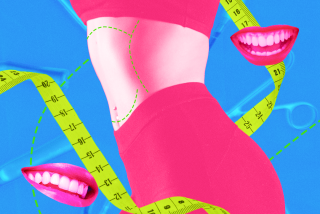Madrid throws models a curve
- Share via
THIS WEEK in Madrid, heroin chic was prohibited. For the first time, the organizers of a major international fashion show recognized that by showcasing emaciated models, the fashion industry promotes eating disorders. Under pressure from the Madrid government, medical associations and women’s advocacy groups, the Assn. of Fashion Designers of Spain finally rejected morbidly thin models.
When selecting models for this year’s Madrid fashion week, which ends today, the designers set a minimum body mass ratio (calculated on the basis of height and weight). Their required ratio was 18 -- meaning a minimum of 119 pounds for a 5-foot, 8-inch woman. The bar was by no means high. For ordinary mortals, a ratio of 18.5 qualifies as underweight. Even so, five of the 68 auditioning models flunked.
To understand why they flunked, we need to look beyond the fashion industry to the true causes of eating disorders. These include genetic predisposition, temperament, family dynamics and personal trauma. I know; modeling fueled but did not cause my own adolescent eating disorder nearly 40 years ago.
Twiggy was my generation’s Kate Moss. I fixated on her at age 13, and by the time I started modeling one year later, I’d dropped 30 pounds. Being skinny became my identity. At 5 feet, 7 inches, I didn’t weigh more than 100 pounds again until I was 21.
My anorexia ultimately destroyed my career.
Models were -- and still are -- paid to make fashions look good, and that meant fitting sample wardrobes. Reigning teen cover girls Shelley Hack and Colleen Corby understood this. In dressing room lunches between shoots, I’d watch them wolf down tuna salad sandwiches while I pretended not to be hungry. They were lucky, I told myself, they could get away with eating. I began to lose jobs when I became so thin that stylists couldn’t even pin dresses on me to look right. Still, I felt I couldn’t eat.
Like many anorexic models, I was drawn to the fashion world because it reinforced my anorexia. I would be willing to bet that most, if not all, of the runway models disqualified in Madrid fit the same pattern -- as do many emaciated gymnasts and ice skaters.
Three years ago, I began interviewing medical researchers as well as middle-age women and men with histories of anorexia and bulimia. I wanted to find out what we know now that we didn’t know in the 1970s, when I quit my self-imposed hunger strike. I learned that researchers now are discovering genetic links between eating disorders, depression and obsessive-compulsive disorder. Genes also shape the temperaments of people who are prone to anorexia and bulimia, although the mechanisms for this are still poorly understood.
A landmark 2003 British study found that certain innate childhood traits, such as perfectionism, inflexibility and cautiousness, each increase an individual’s risk for anorexia by a factor of seven. Someone like me, possessing all five traits measured in the study, is 35 times more likely to develop an eating disorder than a daredevil who happily wears mismatched socks.
Further, eating disorders are triggered not by pictures of Kate Moss but by sudden or cumulative experiences of intolerable emotion, such as shame or fear. Puberty unleashes a natural tidal wave of these emotions. Adolescence also happens to be the age when rates of sexual abuse soar, academic and social pressures intensify and parents become a source of embarrassment rather than solace. It makes sense that this is prime time for eating disorders. Obsession with weight offers a distraction. Extreme weight loss signals distress.
It also makes sense that rates of anorexia and bulimia spike in middle age, when many women again face emotional turmoil. Women over 30 now make up a full third of residential patients at the Renfrew Center, a Philadelphia treatment facility specializing in eating disorders. Divorce, grief, the empty nest -- all can trigger illness if the individual possesses a genetic predisposition.
The onset of eating disorders is like the firing of a gun. Genetics form the gun. Cultural influences such as the fashion industry and familial attitudes about weight then load it. And intense emotional distress pulls the trigger.
Healthier figures on international catwalks may help to disarm the gun. However, of the more than 40 women I interviewed, only a handful had ever paid any attention to fashion. When they started starving, they were asking for help, not admiration. Those models who failed the test in Madrid need treatment, not rebuke.






